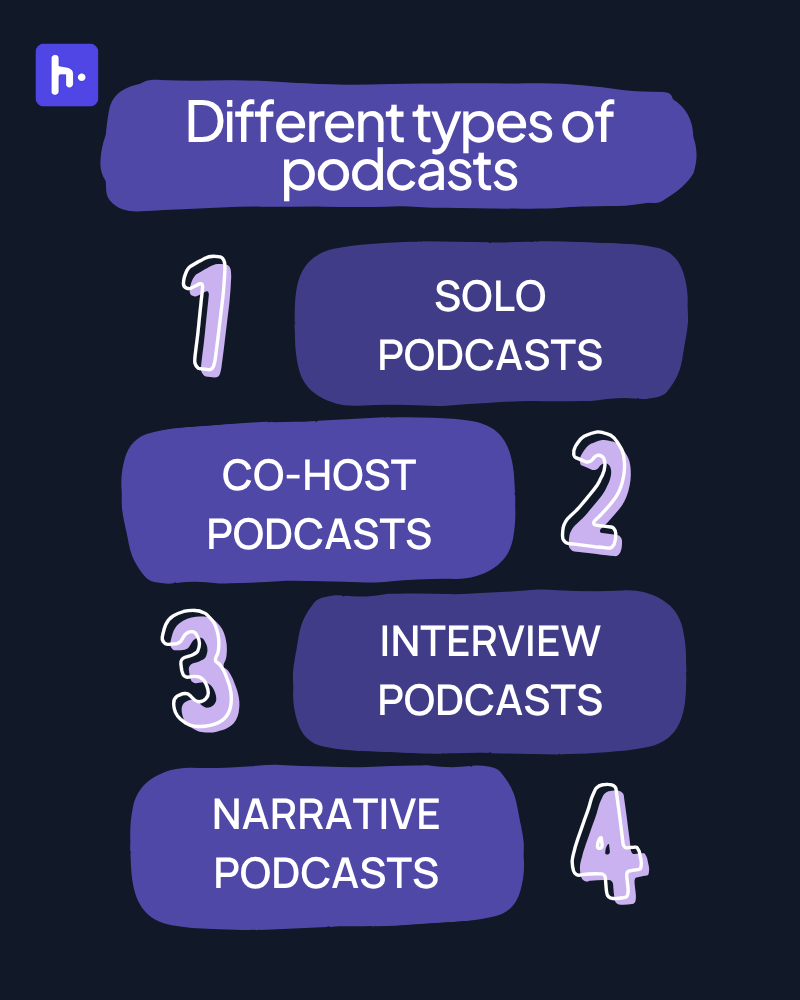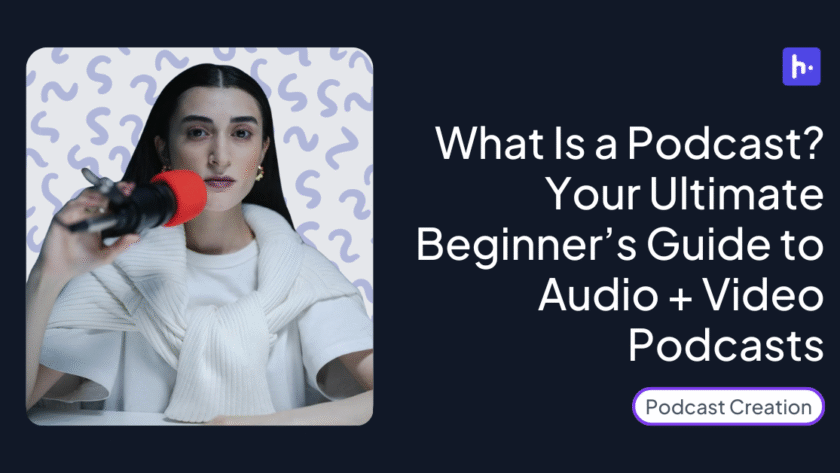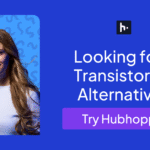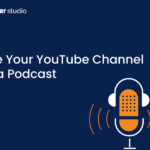A podcast is an audio-first content format that can also exist as video but still makes complete sense without visuals. Unlike tutorials or vlogs, podcasts focus on storytelling, interviews, or conversations that remain engaging through audio alone. They are distributed using an RSS feed created by podcast hosting platforms and are available on Spotify, Apple Podcasts, YouTube, and more. In this guide, learn what a podcast is, how it works, how to start one (audio or video), what equipment you need, and why podcasts have become one of the fastest-growing content mediums globally.
The first podcast was created in 2003 by David Winer and since then podcasts have slowly but surely made their way to mainstream media. With Golden Globes introducing Best Podcast as a category, podcasts have found mainstream media acceptance too.
But, what is a podcast? How does one define a podcast? In this blog, we’re going to discuss the nitty-gritties of podcasts and how they work.
Table of Contents
What is a podcast?
Originally, a podcast was an audio created with the intent of educating, entertaining, or inspiring people that was distributed on various apps where people can tune in. But soon, podcasts have expanded to being video too.
What differentiates a podcast from any other video is that podcasts can be dissected from their video component and still make sense.
For example, prank videos or tutorials require a video element to understand what is being said in the video.
Compare that to a podcast like The Diary of A CEO, where you can watch it, but if you just listen to the audio, the podcast still makes sense.
Podcasts started with David Winer making an audio feed for Christopher Lydon. In 2004, David Winer and Adam Curry developed iPodder, a program that allowed iPod users to download audio content to their iPods making it easy for them to listen to audio content on the go.
Podcast itself is a portmanteau, combining two words Pod (from iPod) and Cast (from broadcast) and was first used by Ben Hammersley in his article for the Guardian.
But unlike other media formats like videos and pictures on social media, you can’t directly upload a podcast (YouTube being an exception) onto various podcast listening platforms like Spotify, Apple Podcasts, Amazon Music, etc.
As a podcaster, you need to create a podcast RSS feed, and the RSS feed is what also makes podcasts different from other media.
What is a podcast RSS feed?
A podcast RSS feed is an XML file where all the podcast details are stored. When you submit the RSS feed to various apps, they fetch data from this file and make it available to podcast consumers.
You can create a RSS feed on your own, but it is a time consuming process and needs constant updation when you want to distribute your podcast. Thus, a podcaster opts for a podcast hosting platform instead, that creates the RSS feed for them. They simply need to create their podcast on their hosting platform, fill in the necessary information like:
- Podcast name
- Description
- Category
- Language
- Podcast cover art
- Episode file
- Episode title
- Episode description
The hosting platform will create the podcast RSS feed that can be distributed to various podcast listening platforms and directories so that their audience can listen to it.
How do podcasts work?
Podcasts work via RSS feeds that the podcaster distributes to various platforms so that the listeners can listen to it.
A podcaster will plan, script, record and edit their episode which they will upload on their podcast hosting platform.
The hosting platform will update the RSS feed automatically, and then the episode will be publicly available on various platforms that the listeners can listen to when they want to.

Difference between “podcasts” and “episodes”?
What is a podcast and a podcast episode? Many people confuse podcasts and episodes. The difference between the two is the same as an album and the songs within it. The album is what a podcast is and the episodes are the songs within that album.
For example, The Joe Rogan Show is a podcast that has various episodes within it.
What is the purpose of a podcast?
Just like any other form of media, the purpose of a podcast is to communicate with the audience. The intent behind the communication can be to educate, entertain, or inspire an audience.
Every podcaster has their own way of achieving some or all of these purposes, and once the audience resonates with the host’s purpose of creating the podcast, it has achieved its goal.
Different types of podcasts
Now that we have a strong understanding of what is a podcast, we must understand that there are different types of podcasts, mainly divided on the format of the show:

Solo Podcasts
These podcasts have only one host that talks to their audience. They can either entertain or educate their audience. While the solo podcasters have a lot of flexibility and freedom of expression, it can create a lot of responsibility on the podcaster to keep the show going.
Co-host Podcasts
Contrary to solo podcasts, these podcasts have more than one host. This makes the podcast dynamic and adds a unique flavour to the podcast. Whether it is an educational or entertainment podcast, co-host podcasts work for both of them.
Interview Podcasts
As the name suggests, this podcast is where there is an interview with a person, where one person asks questions and the other answers. Usually, in these podcasts there is a constant host (or multiple hosts) and the guests on each episode differs.
These guests are usually distinguished and experts of their field. The host poses questions and the guest answers, sharing their expertise, experiences, and opinions.
Narrative Podcasts
Podcasts where the narrator or a team of voice actors are narrating a story are narrative podcasts. These usually have immersive sounds too, to further create an engaging experience.
Reasons podcasts are famous
Podcasts gained a lot of popularity due to the following reasons:
Passive Consumption
Audio podcasts specifically can be listened to while you’re commuting, doing dishes, laundry or going to sleep. They’re a great way to not only enjoy the mundane chores of life but also cut down your screen time.
Education
Podcasts are consumed to learn about something. Many educational podcasts are long and in-depth, discussing every aspect of the topic to give the listeners an in-depth perspective.
A good example of this is the Huberman Lab, where Dr. Andrew Huberman, a Stanford professor in the neurobiology department talks about neuroscience. His podcasts run over an hour but they discuss topics in-depth, giving listeners a novel experience.
Easy to create
For podcasters, creating an audio podcast doesn’t require much equipment. You can get started with just a microphone and laptop. It makes it easy for busy people or people who have something to share with the world, start podcasting.
Variety
With podcasting becoming more prominent, many people have started creating their podcast which means more podcasts in small niches.
Affordability
Podcasts are free to listen to and therefore many people tune into them for free education and entertainment.
Personal Growth
Many podcasts are about self improvement with real life stories from people who have gone through situations many listeners can relate to, and therefore podcasts act as a great tool for personal development.
Examples of famous podcasts in 2025
Rotten Mango
Rotten Mango is a true crime podcast hosted by Stephanie Soo that dives into horrific crimes. The podcast is popular and has garnered a substantial fanbase on YouTube (5.3 million subscribers) and can be heard on podcast listening apps.
The true crime genre is popular among podcast listeners. In fact 42% of the US population aged 13 and above enjoy true crime podcasts.
The Joe Rogan Experience
Hosted by Joe Rogan, this podcast has episodes with influential personalities like Elon Musk, Donald Trump, Naval Ravikant, Neil deGrasse Tyson, and more. Most of his podcasts are over an hour and follow a conversational flow rather than a strict interview format.
With both an audio and video approach, his podcast is one of the most popular podcasts in today’s day and age.
Kill Tony
Kill Tony has a unique premise where aspiring comics come on stage and perform in front of a jury where they get roasted in front of a live audience. Tony Hinchcliffe has garnered a massive audience on YouTube and has a loyal audience that comes back for each episode.
The novelty of the show, owing to the new comics each episode, makes the show fresh and unpredictable and keeps people on the edge of their seat.
Call Her Daddy
Call her Daddy podcast by host Alex Cooper is a podcast on dating and is a popular podcast among women. The podcast got acquired by Spotify and is focusing on mental health by calling psychotherapists on the show. The podcast is known to cover bold themes and thus caught the attention of its audience.
What is a podcast on YouTube?
A podcast on YouTube is of two types. The audio podcast where an auto-generated video is created with a static cover art. The second type is where the video of the podcast host and/or guests are recorded and uploaded onto YouTube.
YouTube has become a preferred podcast listening platform for 33% of monthly podcast listeners in the US. With over a billion active users on YouTube, it is slowly becoming a big player in the podcasting space.
Who creates podcasts?
Podcasts can be created by multiple people, here are common creators of a podcast:
- A single individual who wants to share their expertise with a niche audience. Their purpose is to share their knowledge.
- A single individual who wants to entertain people and have either anecdotes, stories, or jokes to share with their audience.
- A brand who wants to create a podcast for top of the funnel awareness and increase trust for their brand in their customers.
- A freelancer or coach who wants to share their expertise with their niche clients, build trust, and generate leads for their business.
- A content creator who wants to branch out into podcasting and create another vertical of content.
- Celebrities who leverage podcasts to solidify their personal brand, and increase their relevance in the digital world.
- Government organizations who want to increase awareness for their policies and schemes.
- Organizations who want to streamline their communication with their employees and create a private podcast to share company updates.
- Schools and colleges that use a private podcast to share additional educational resources to their students.
How to start a podcast?
Starting a podcast is super easy and simple. Here’s how you can start an audio podcast:
- Choose your podcast topic.
- Pick a name for your podcast, you can also use a free AI podcast name generator to get names quickly.
- Create a podcast outline for your first episode, or write a script. This depends on your comfort level, podcast topic and type.
- Record your episode with a mic and laptop. (more on what equipment is needed for a podcast later).
- Edit your episode.
- Create your account on your choice of podcast hosting platform.
- Upload your episode and publish it.
To create a video podcast, here are the steps you need to follow:
- Choose your podcast topic.
- Pick a name for your podcast, you can also use a free AI podcast name generator to get names quickly.
- Create a podcast outline for your first episode, or write a script. This depends on your comfort level, podcast topic and type.
- Record your episode with a camera, mic and laptop. (more on what equipment is needed for a podcast later).
- Edit your episode
- Create your account on your choice of podcast hosting platform. Pick one that supports both audio and video podcasts.
- Upload your video file and publish it.
If you want a detailed guide on how to start a podcast, we have a blog just for you with a free Notion Checklist too, check it out.
What equipment is needed for a podcast?
The equipment you need for your podcast depends on the type of podcast you’re shooting.
Equipment needed for an audio podcast
The primary piece of equipment in any podcast is the microphone since the clarity of the audio is pivotal for a podcast.
If you’re just starting out, the mic of a wired earphone can give you better quality audio than your phone or laptop’s in-built microphone.
You can use AI voice enhancers like Adobe Podcast to increase the quality of your audio and remove background noises. Although, we would suggest you record your episodes at night since the background noises are less and it’s quieter.
If you have the money to invest in a mic, budget options include lapel microphones, and bluetooth microphones.
If you have the budget, buy a condenser microphone. If you have multiple guests, buy a condenser mic for each speaker. Once you have multiple mics, you’ll need a podcast recorder that prevents audio overlapping.
Our recommendation for mics and podcast recorder have been discussed in this blog on podcast tools.
Equipment needed in a video podcast
Since your setup would be visible, investing in either bluetooth mic or condenser microphone would be ideal. Bluetooth mics avoid the visual clutter caused by wires and many come with multiple mics to accommodate multiple guests. They also connect with a phone or camera.
To shoot your video, you can start with just your smartphone since the cameras on most smartphones can give a good video output, especially if you use the back camera.
If you want to invest in a camera, you can consider Sony ZV1. It captures 4K video, has a flip screen so if you’re shooting solo you can see the frame. It also connects to your computer and won’t auto shut off while recording, which is perfect if you’re recording remotely.
Podcast Setup
For an audio podcast setup you just need your equipment, a space with minimal background noise, and no echo. You can use foam sheets or thick bedsheets and carpets to reduce echo in your room. Since the audience can’t see where you’re shooting, you don’t need an aesthetic space.
Your surrounding’s visual appeal matters when you’re shooting a video podcast. Make sure the background is clutter free. You can make your background aesthetically pleasing by putting a bookshelf and lamp in the background. To take it a step further, you can put your podcast’s logo or name in the background as well.
The camera setup will differ based on the number of people in the podcast.
If you’re shooting solo, the camera should be focused on you. You may use an additional camera that shoots you from a different angle and can result in an engaging video since you can have two POVs that make the video seem more dynamic while you’re just sitting and talking. However, it is not a requirement.
With two people in the frame, you can still use a single camera to shoot since it can capture both the speakers clearly. Multiple cameras will again add a dynamic element to your episode.
With multiple people in a frame, you will need multiple cameras capturing the guests and the host(s). Using a single camera should be avoided since fitting multiple people in one frame is difficult.
How to listen to podcasts?
Podcasts are available for free for the most part. Some podcasters have a public podcast and a members exclusive private podcasts that are behind a paywall. But, most podcasts are free. To listen to podcasts you can download any podcast listening app. The most popular ones are:
- YouTube and YouTube Music
- Spotify
- Apple Podcasts
- Amazon Music
- JioSaavn
- Castbox
- PodLP
- Stitcher
You can download the app for these platforms, they’re available for both Android and iOS users.
What is a podcast? Our final thoughts
So, what is a podcast? At its core, a podcast is either an audio or video that allows anyone with a voice to share stories, knowledge, or conversations with a global audience which uses RSS feeds for their distribution.
Podcasts became popular due to listeners’ need for content that can be heard passively, in-depth education, low barrier for entry, no cost associated with listening to them, and the need to connect with a niche audience.
Podcasts are growing and becoming mainstream day by day. If you want to start a podcast right now is the best time to start a podcast. Here’s a complete guide on how to start a podcast for free.
What are podcasts frequently asked questions (FAQs)
What is a serialized podcast?
A serialized podcast is a podcast where each episode follows the story or information in the previous episode. Usually, a storytelling or narrative podcast is a serialized podcast since each episode is like a chapter in a fictional book.
What is a video podcast?
A video podcast is a video which is created with the intent of educating, entertaining, or inspiring and a large focus is on what is being talked about more than the visual aspect of the video.
Are podcasts free?
Yes, podcasts are free to consume and are available on various streaming platforms like Spotify, Apple Podcasts, JioSaavn, Amazon Music, castbox, etc.





